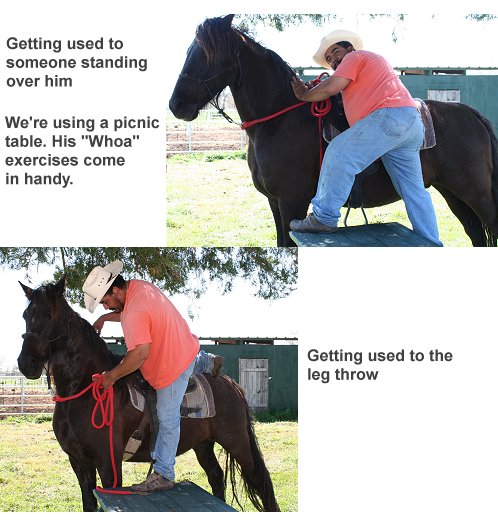Following Reign’s progress – mud and all.
Reign has worn his saddle every day for 3 hours for a week. He has had bumpers on every part of his saddle and has grazed in the pasture – adding treat to insult. He now looks forward to his saddle because it means lots of green grass.
 The first thing he should become used to is people taller than he is. I start this with people sitting on the fence. When I know he is steady in the round pen, bystanders are asked to sit on the rails of the fence. He is introduced to them first by walking up to them. Then asked to lunge with them sitting up there. Ask him to lunge, work, then take him to the “tall” person to rest. He will soon like to go to the fence where an on-looker is stationed.
The first thing he should become used to is people taller than he is. I start this with people sitting on the fence. When I know he is steady in the round pen, bystanders are asked to sit on the rails of the fence. He is introduced to them first by walking up to them. Then asked to lunge with them sitting up there. Ask him to lunge, work, then take him to the “tall” person to rest. He will soon like to go to the fence where an on-looker is stationed.
When he seems calm with all of this, we walk him up to them again and start the fence-sitters reaching out with their foot or leg to touch him from this high position. We want to be able to touch him and bump him and ultimately rub his face when he approaches.
(“Above-me” training can also be accomplished if you have a 2nd horse and are a competent enough rider to pony your un-started colt. Ponying allows him to get used to moving with someone above him – albeit on the adjacent horse)
After we have done the Jeffrey’s Method of mounting and his saddle is like a 2nd skin, we introduce mounting with a saddle. You can see in these pictures that Reign was calm enough to be introduced on a loose lead at a picnic table on the ranch property near the round pen. First just getting him close to the table and asking for his , “Whoa”. Then leaning over the saddle, then putting your foot up over his rump (bumping a little to desensitize him to a sloppy mount).

Next it was time to send someone all of the way up. Danielle volunteered to be the first to mount this guy. First she put weight into the stirrup and leaned up over him, rubbing the other side. After this was accomplished two or three times, she relaxed, stayed a little longer for a nice rub down.
Then she mounted with more gusto and sat higher with her knee on the saddle seat but not all of the way over and her other foot only lightly in the stirrup. This is a little like the Jeffrey’s method in that she can dismount quickly if we encounter any trouble. Her legs are not on both sides of the horse, and her foot shouldn’t get caught in the stirrup.
There is a problem here – in these pictures – as often presents itself when relative novices are demonstrating for the camera. It should be noted that Reign did not have his head flexed around toward her as she was doing all of this mounting run-up. If he were going to buck, he could have shot directly forward (even on top of the ground handler). The first weight in the stirrup should be done with the horse’s head pulled toward the rider’s side. Due to Reign’s personality, Danielle remained safe and he remained calm.

Even horses who initially bucked and objected to their saddle rarely give any trouble at taking their rider if they have been properly prepared on the ground. They must be respectful! They must have been lunged at every gait in every direction. They must have given you the leadership nod during all of their previous ground training. The fight should be totally gone by this point.
Reign was calm and easy during all of these exercises. However, had he been nervous or apprehensive, we would not have been in an open pasture.
The full mount is next. I don’t risk the full mount in the open regardless of the horse’s apparent state of mind. We went to the round pen.

Thanks to Danielle de Medeiros for the great demonstration riding and training
At this point, Reign has not “walked” with a rider in the saddle. He has taken a step or two but not really moved in any meaningful way. That is next.
Under no circumstances should information presented here be construed as veterinary in nature. Always consult your veterinarian if problems persist. Additionally, horse training and equestrian activities in general can be dangerous. While we try to present relevant and valuable content, under no circumstances does horse-pros.com or its members or contributors take any responsibility for the well-being of any horse or person using a method outlined here.
We certainly don’t know everything. Please share your expertise. Comment on what is already written or Suggest a Category and Educate us about it. Grow Horse-Pros.com©